For those who aren’t really into watches, or are fairly new to the world of Rolex, the name Turn-o-Graph may be unfamiliar. Discontinued in 2011, it is no longer part of the Rolex catalog, and in its lifetime, was largely overshadowed by greats such as the Daytona, Explorer, and Submariner.
However, it is a watch with an interesting and remarkable history. In fact, it served as the origin of many of the hallmark traits we see in Rolex watches today.
The Rolex Turn-o-Graph is the brand’s pioneering tool watch. Launched in 1953, it introduced a host of firsts for Rolex. It became the first commercially available Rolex watch with a rotating bezel (not the Rolex Submariner, as many would believe), and also their first sports watch to be released in Rolesor finish, or the combination of steel and gold.
 Modern and vintage Rolex Turn-o-Graph models – references 116261, 116264, and 16253
Modern and vintage Rolex Turn-o-Graph models – references 116261, 116264, and 16253
Combining practical functions and a sporty-elegant design, it helped pave the way for a new genre that is ubiquitous today – the tool watch.
The ingenious rotating bezel would later on be a key feature in the brand’s most iconic sports watches, namely the Submariner and GMT-Master. While it was initially a stand-alone model, the Turn-o-Graph was later absorbed into the Datejust family, becoming the de facto sporty model from the collection.
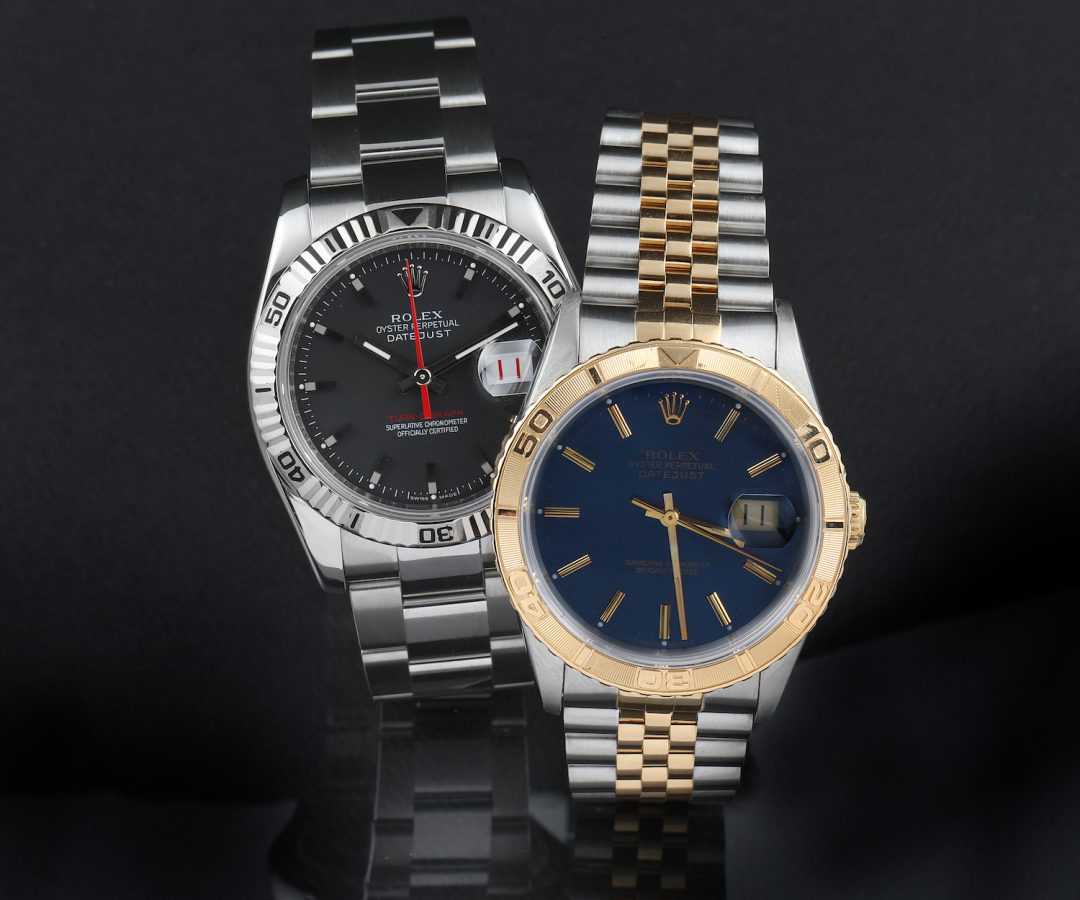 Modern and vintage Rolex Turn-o-Graph models – references 116264, and 16253
Modern and vintage Rolex Turn-o-Graph models – references 116264, and 16253
As the interest in vintage watches grew, the Turn-o-Graph received cult status among Rolex collectors and vintage watch enthusiasts. The watch world has finally caught on with the Turn-o-Graph’s combined elegance and sporty appeal, not to mention its storied past. It’s a timepiece that truly deserves the attention it is getting in this day and age.
Learn more about the history and models within the collection with SwissWatchExpo’s Rolex Turn-o-Graph Ultimate Guide.
A Brief History of the Rolex Turn-o-Graph
The Rolex Turn-o-Graph first hit the market in 1953. While it was not designed for a specific sport, it came with a highly practical new feature – a rotating timing bezel. The launch of the Turn-o-Graph began as an experiment, with Rolex seeking to test how the market would respond to the new feature, which presented a new and easier way of measuring elapsed times.
Rolex’s period advertisements for the Turn-o-Graph presented it as a reliable tool for sports and around the house. Marketing copy introduced it “as a reminder of times past, for phone calls, conferences, timing, parking, and countless other ways”.
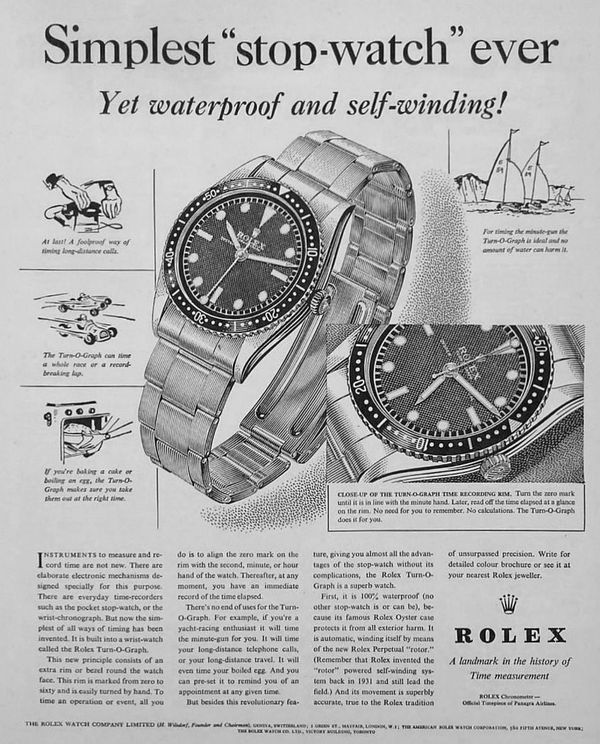 Vintage Rolex Thunderbird advertisement (photo: Vintagegoldwatches.com)
Vintage Rolex Thunderbird advertisement (photo: Vintagegoldwatches.com)
The unique bezel was launched with the Turn-o-Graph’s inaugural reference 6202, which had a thick black rotating bezel. The ref 6202 is also Rolex’s first serially-produced watch with a rotatable bezel, beating the Submariner by only a few months. It was marked with a 60-minute scale to give the ability to quickly measure elapsed time – and with that it became Rolex’s original tool watch.
It does share a number of similarities with the Submariner – a black dial with a gilt chapter ring, dot and baton hour markers, and a triangle marker at 12 o’clock. Just like the first Submariner model, the ref 6202 was also a time-only model and was not yet equipped with a date function.
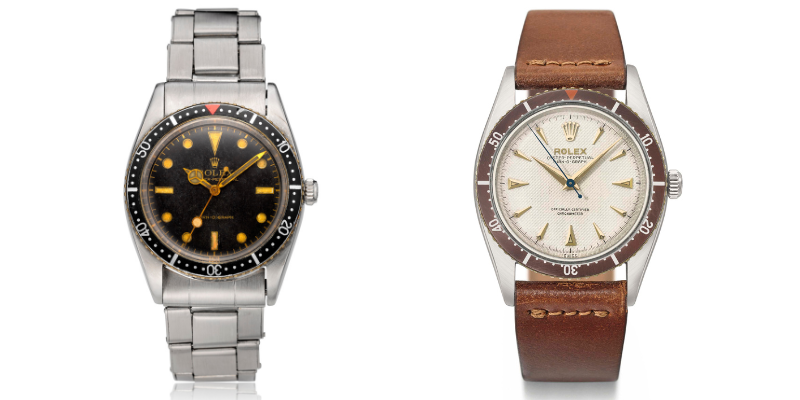
Rolex Turn-o-Graph reference 6202 models (photo: Christie’s)
However, the Turn-o-Graph’s resemblance to the Submariner ended with its second generation, which was introduced just a year later. All subsequent models of the collection were absorbed into the Datejust family, which meant it gained a date function, displayed through an aperture at 3 o’clock, and magnified with a Cyclops lens right above it on the crystal.
While it retained the turntable surround, the black aluminum insert was changed to embossed metal, finished off with an engine-turned design, following the Datejust’s dressier aesthetic. This helped distinguish the next series of the Turn-o-Graph – reference 6309 and 6609 – from the Submariner, which was launched just the year after.
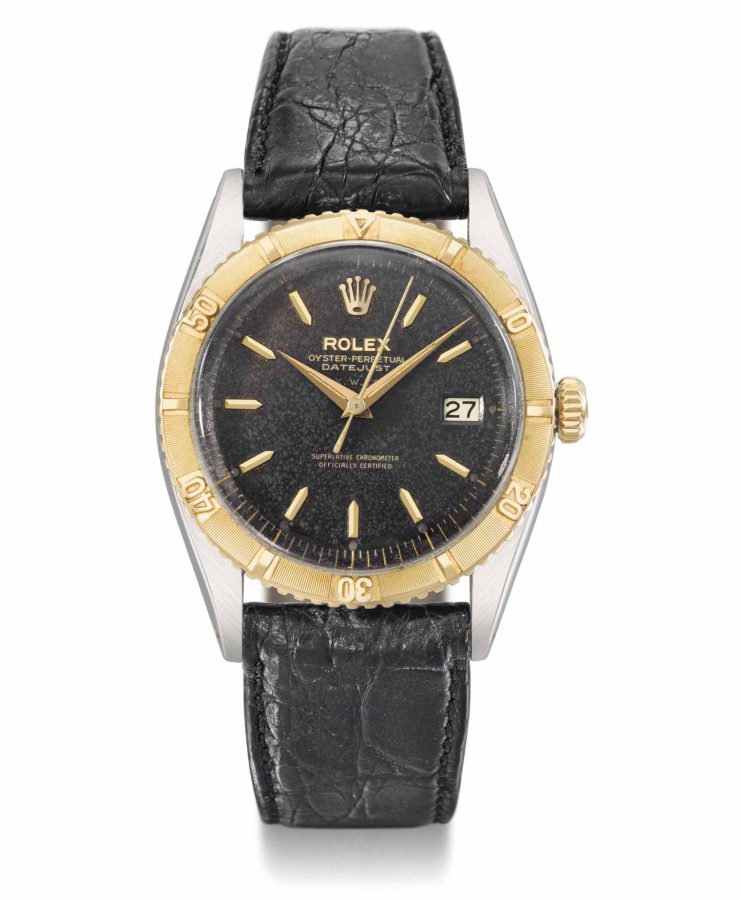
Rolex Turn-o-Graph reference 6609 (photo: Christie’s)
By the end of the decade, the Turn-o-Graph’s genuinely useful function caught the attention of the United States Airforce aerobatics squadron, also known as “The Thunderbirds”. It proved useful in aiding their navigational calculations, and at their request, the watch became the official timepiece of the unit. Rolex recognized this opportunity and promptly named the Turn-o-Graph “Thunderbird” in the North American market.
From 1959 to 1977, the Turn-o-Graph was given various upgrades:
– the switch to Caliber 3035, known as one of the best mechanical calibers made by Rolex
– the text Turn-o-Graph was removed from the dial, and the inscription “Superlative Chronometer Officially Certified” was added. This essentially made the Turn-o-Graph a Datejust watch, only with a rotating bezel.
– finishing was mostly two-tone steel and yellow gold, which were all the rage at the time, although some solid gold models exist
The next upgrade came in 1988 when Rolex introduced five-digit models with sapphire crystals. Solid gold models were also discontinued in favor of steel and two-tone models.
 Modern Rolex Datejust Turn-o-Graph models – reference 116263, 116264, and 116261
Modern Rolex Datejust Turn-o-Graph models – reference 116263, 116264, and 116261
In 2004, to commemorate the 50th anniversary of the Turn-o-Graph, Rolex releases a newly designed range of Turn-o-Graph watches. They feature bezels that merged the functionality of the rotating timing bezel with the signature fluted bezel of the Rolex Datejust. The new range of Turn-o-Graph watches also introduced rose gold into the collection, with a Rolesor steel and rose gold model.
The Rolex Datejust Turn-o-Graph was eventually discontinued in 2011. With its sporty-elegant looks and place in Rolex’s history, this underrated classic remains sought after among Rolex fans today.
Generations of the Rolex Turnograph
While the Turn-o-Graph’s design shifted throughout the years, its distinguishing feature – the rotating timing bezel with 60-minute graduations – remained all throughout its lifespan.
Only the first and final generations of the Rolex Turn-o-Graph have the model name printed on the dial, but it can still be easily identified from a standard Datejust by looking for these graduations on the bezel.
Here are key features of every generation of the Rolex Turn-o-Graph:
First generation (1953 – 1959)
Reference Numbers: 6202, 6309, 6609, 1625
The inaugural reference 6202 introduced the rotating bezel with 60 unit markers, and at the time, the bezel was made of Bakelite. This model was crafted in stainless steel and equipped with a glossy black dial and a gilt (gold plated) chapter ring.
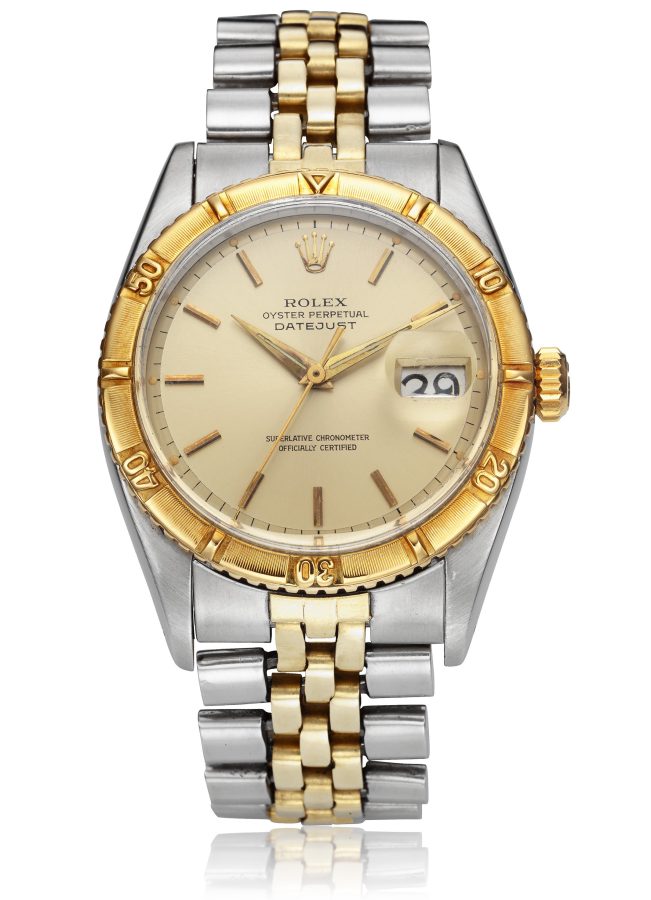
Rolex Turn-o-Graph reference 6202
Rolex followed it up with a few units of the reference 6202 in stainless steel and yellow gold, which was really ahead of its time. It was very quickly discontinued, and only a handful of models are known.
The second series – reference 6309 and 6609 – introduced an upgraded movement, and amped up the dressy aesthetic with solid gold editions. They were produced from 1954 to 1959.
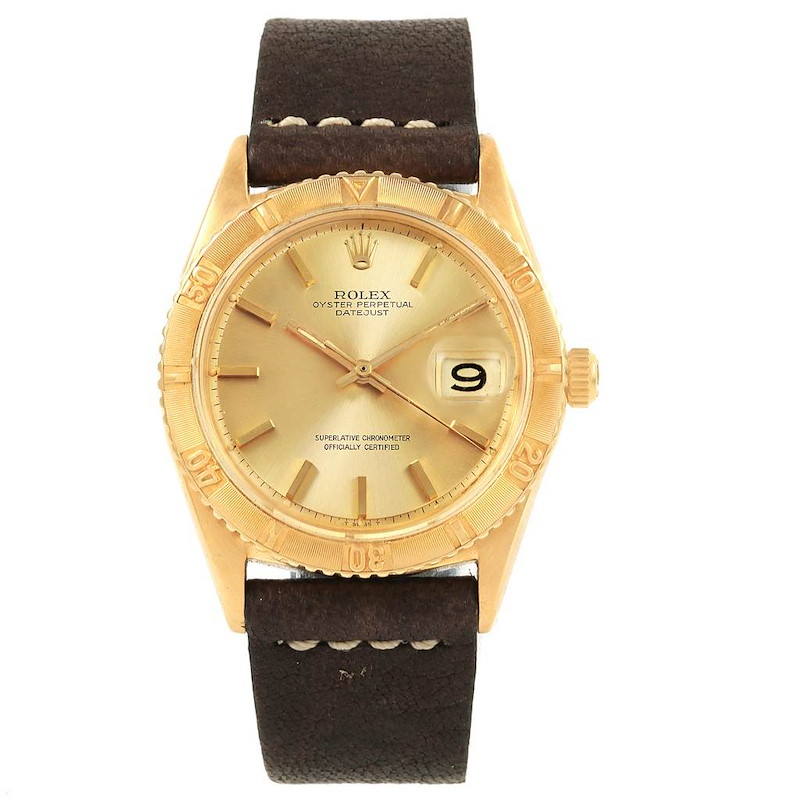
Rolex Turn-o-Graph reference 1625
The third series – reference 1625 – officially made the Turn-o-Graph a part of the Datejust collection. The “Turn-o-Graph” text was removed from the dial, leaving only “Datejust” and adding “Superlative Chronometer Officially Certified”. Two main variations of the 1625 were made available – both in stainless steel, with a choice between a white gold engine turned bezel, or a yellow gold bezel with matching center links. Several bracelet options were also offered, from the Jubilee and Oyster, to leather straps.
While the collection is named the Turn-o-Graph in Rolex literature, it was also marketed as the “Thunderbird” in North America. By the end of the 1950s, Rolex supplied the US Air Force’s aerobatic squadron (named Thunderbird) with Turn-O-Graph watches, as the rotating bezels proved handy in navigating flight calculations.
Second Generation (1977 – 2000)
Reference Numbers: 16263, 16264
In 1977, Rolex discontinued the 1625 and introduced the five-digit references of the Rolex Turn-o-Graph. This meant an upgrade from plexiglass to more scratch resistant sapphire crystal, and equipping the timepiece with the mechanical caliber 3035. Once again these models were available in Rolesor, with steel cases and white gold bezels, and yellow gold bezels and center links.
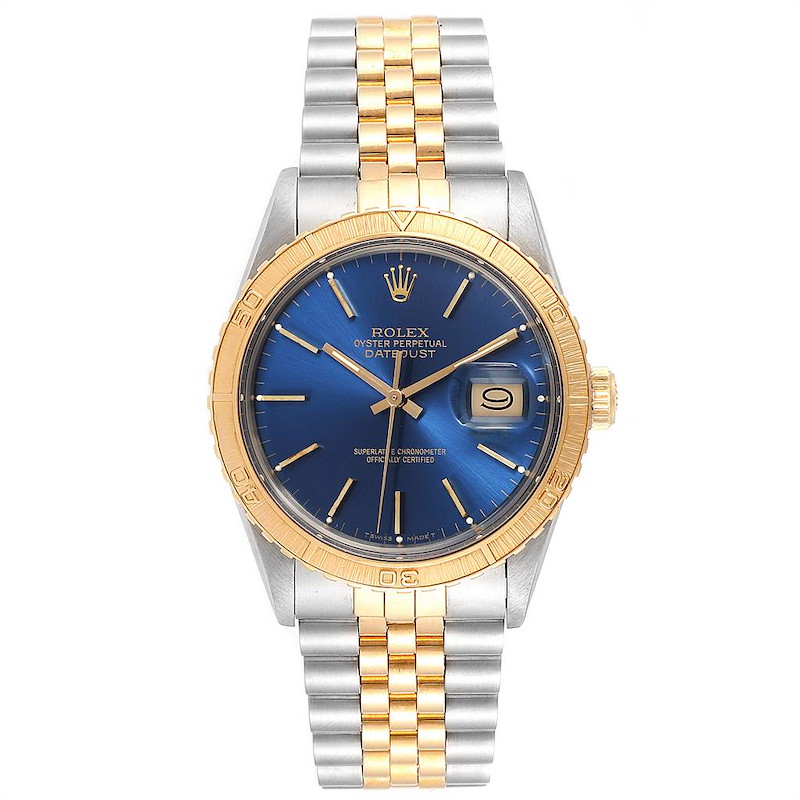
Rolex Turn-o-Graph reference 16253
The first of the family’s five-digit references, the 1625X, brought in the now-standard high beat frequency movement. That said, it was a short lived series, and was replaced in 1988.
The ref. 16253 represents perhaps the most quintessentially ‘Rolex’ look out of all the permutations in which it was issued, its two-tone bodywork, paired with a Jubilee bracelet, a virtual trademark of the company. This reference was made available with various dial colors – from basic black, silvered, champagne, and blue, to Buckley Dials and tapestry patterns.
Final Generation (2004 – 2011)
Reference Numbers: 116261, 116263, 116264
In 2004, to celebrate the 50th anniversary of the Turn-o-Graph, Rolex unveiled a modernized version of the watch, and what would be the final generation of the Datejust Turn-o-graph.
 Modern Rolex Datejust Turn-o-Graph models – reference 116263, 116264, and 116261
Modern Rolex Datejust Turn-o-Graph models – reference 116263, 116264, and 116261
While the 36mm case size remained, the bezel and lugs were more noticeably tapered, in the same proportions as the modern Datejust. The bezel was also changed from engine turned to fluted, and dynamic red date, red seconds-hand, and red “TURN-O-GRAPH” lettering were added. They were made available in three metal combinations and were produced until 2011.
Ref 116263 – steel and gold
Ref 116261 – steel and rose gold
Ref 116264 – steel and white gold
Rolex Turn-o-Graph Reference Numbers
The Rolex Turn-o-Graph was produced from 1953 to 2011, with a total of 10 references:
| REFERENCE | MATERIALS |
| 6202 | Stainless steel with Bakelite bezel and Jubilee bracelet; steel and gold with gold bezel and center links |
| 6309 | Yellow gold with Jubilee bracelet |
| 6609 | Steel and yellow gold with “Thunderbird” bezel and the squadron’s insignia on the dial |
| 1625 | Steel with either a yellow gold or white gold Thunderbird bezel and Jubilee bracelet |
| 16253 | Steel and yellow gold with black dial |
| 16263 | Steel and yellow gold with champagne or silvered dial |
| 16264 | Steel and white gold bezel |
| 116264 | Steel and white gold bezel |
| 116263 | Steel and yellow gold bezel and center links |
| 116261 | Steel and rose gold bezel and center links |
How to Use the Rolex Turn-o-Graph
The most distinguishing feature of the Rolex Datejust Turn-o-Graph is its 60-minute bezel, which can be rotated and used together with the watch’s minute hands. Together, these allow the wearer to calculate two different types of measurements – elapsed time or a specific interval, so long as the duration is under one hour. This is why the bezel shows units from 0 to 60.
Here’s how to use the Rolex Turn-o-Graph:
1. Use the minute hand as a reference hand.
As the Rolex Turn-o-Graph uses its central minute and hour hands to tell the time and to measure elapsed time, you would need to reference the minute hand first when preparing your watch for timing an activity. This marks the starting point of the event that you want to time.
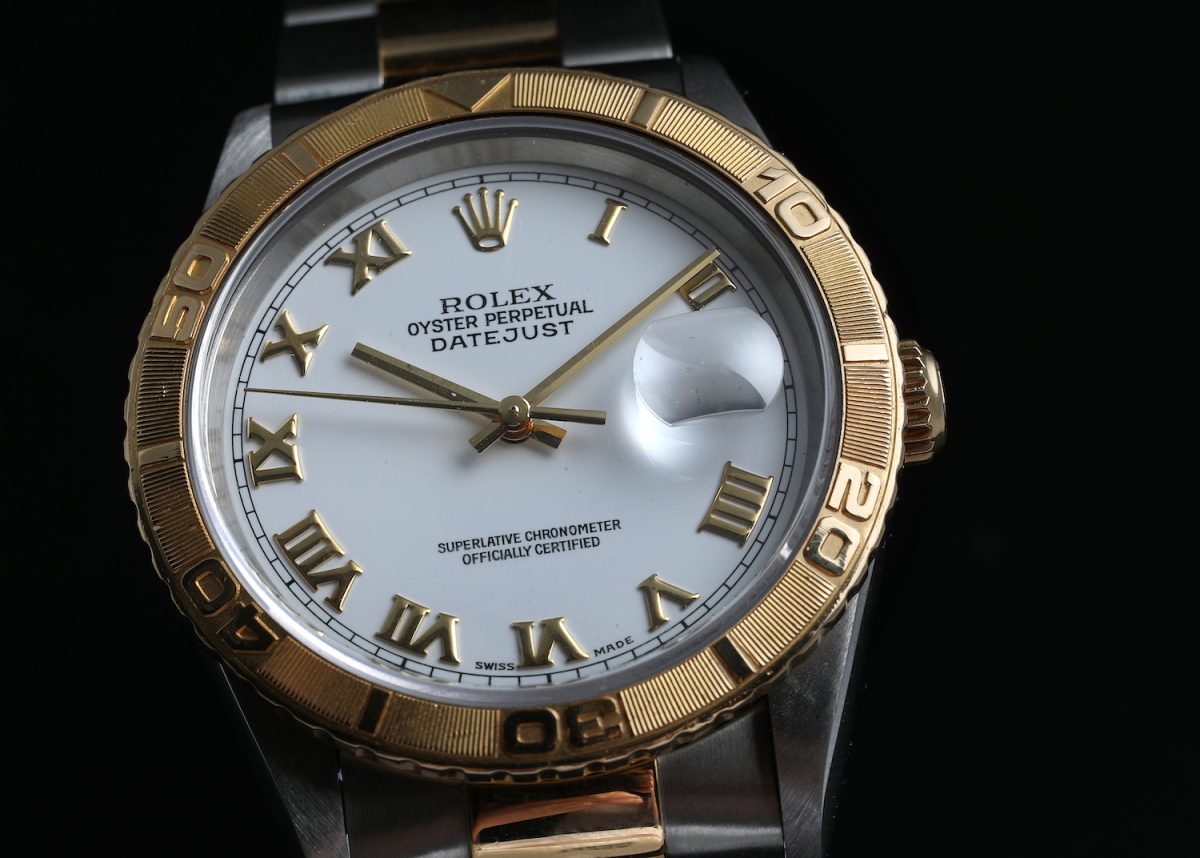 Rolex Turn-o-Graph reference 16263
Rolex Turn-o-Graph reference 16263
2. Align the 0 marker with the minute hand by rotating the bezel clockwise.
Since you’re also using the central hands of the Rolex Turn-o-Graph to time an event, they will keep moving when the watch is running. It’s then necessary to mark the beginning of the activity you are timing, and to do this, you want to rotate the bezel until the 0 mark (marked by the triangle at 12 o’clock) is aligned with your minute hand.
3. To read the elapsed time, use the minute hand’s final position on the bezel as reference.
As the minute hand of your Turn-o-Graph moves in clockwise direction, you can now measure the time passed by referencing the minute hand’s final position vis a vis the 60-minute timer on the bezel.
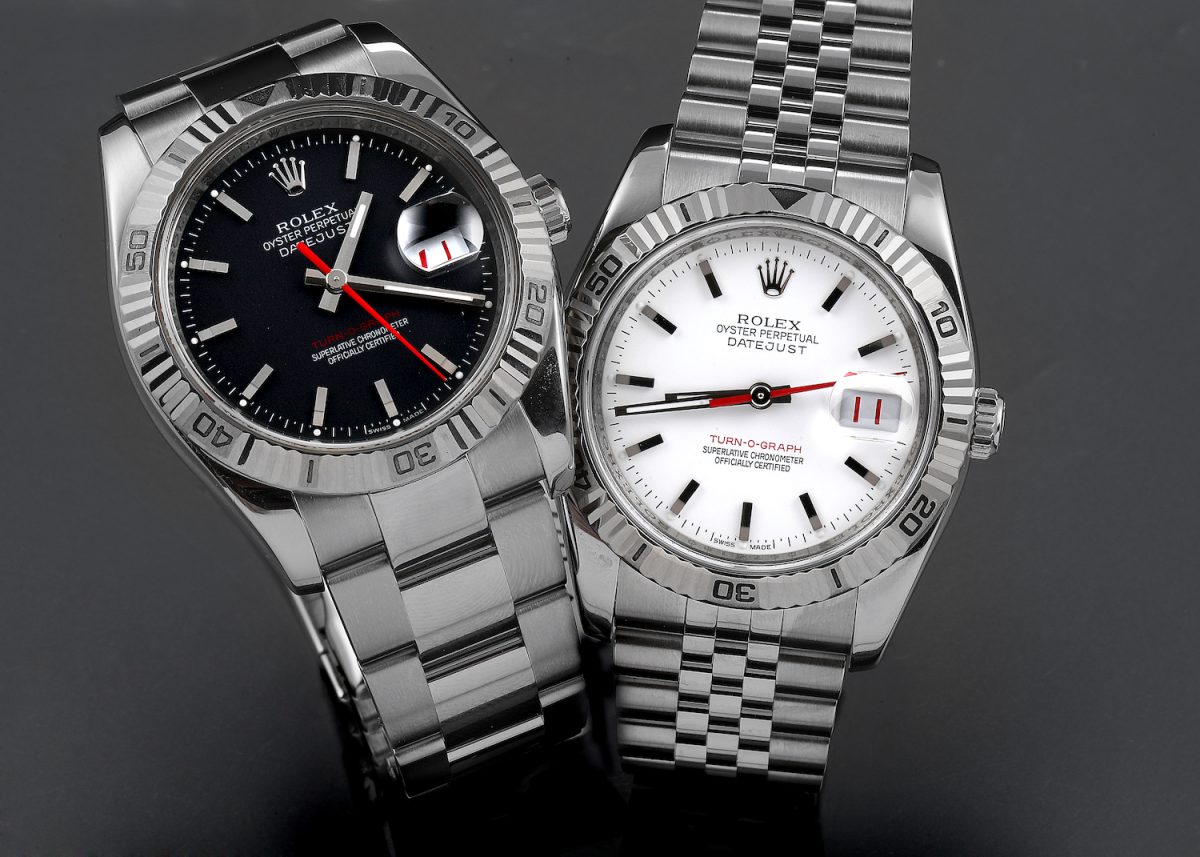 Modern Rolex Datejust Turn-o-Graph reference 116264
Modern Rolex Datejust Turn-o-Graph reference 116264
4. Record the time elapsed.
As explained, the hands on the Turn-o-Graph will continue to run when timing (versus stopping it such as when using a chronograph), so you need to record the minutes passed when you’re through timing the activity.
5. If you need to time past one hour, add the appropriate number of hours.
While the bezel of the Rolex Turn-O-Graph is only marked up to 60-minutes, you can still time activities that exceed one hour. If the minute hand has done a complete rotation around the dial, just add the corresponding number of hours when you’re through timing the activity.
Most Notable Rolex Turn-o-Graph Models
The Rolex Turn-o-Graph was produced in a total of 10 references in its lifetime. Here are the most sought after of them all.
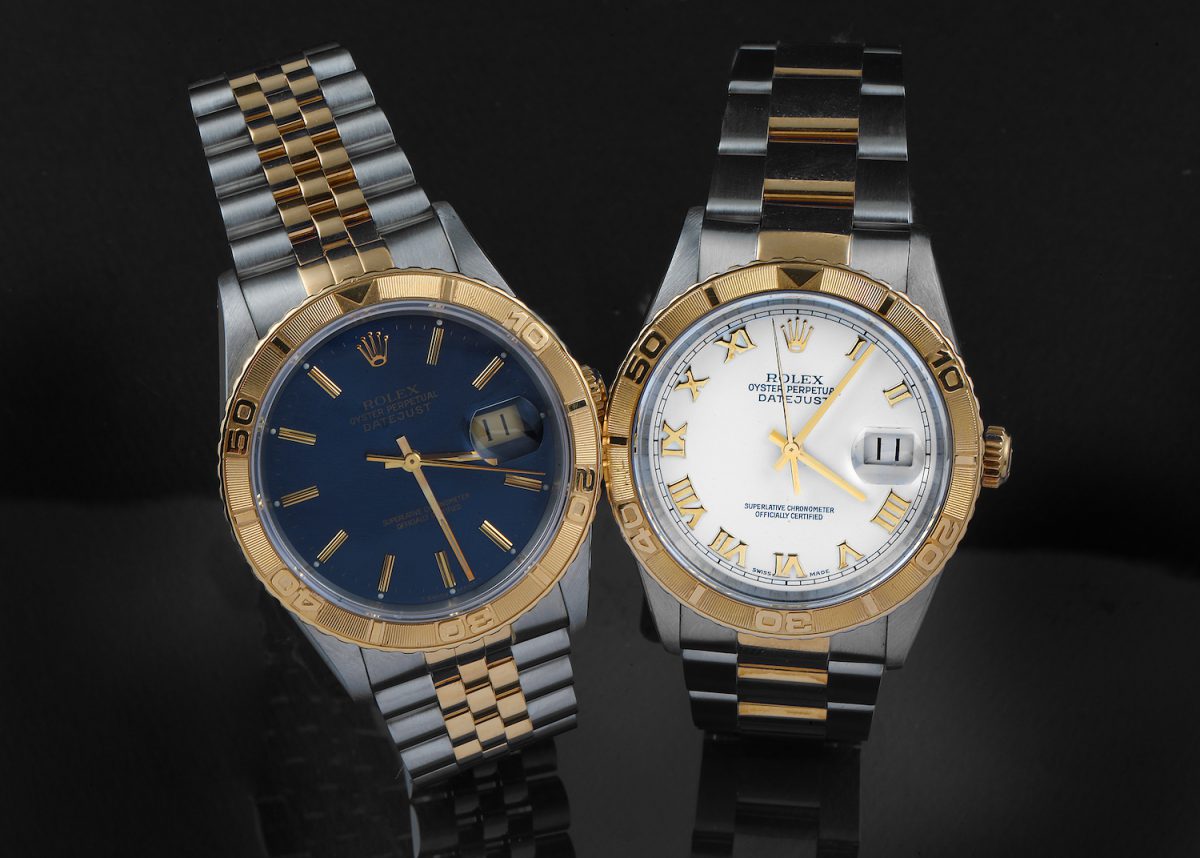
Rolex Turnograph Datejust Steel Yellow Gold 16253
The reference 16253 was introduced in 1977 as part of the second generation of the Turn-o-Graph. It represents the quintessential Turn-o-Graph model with its classic two-tone style, Jubilee bracelet, and distinct engine-turned outer bezel. Various dial styles were made available with this reference, from classic colors like black and champagne, to the more distinct Buckley Dial with painted numerals, and tapestry patterned dial.
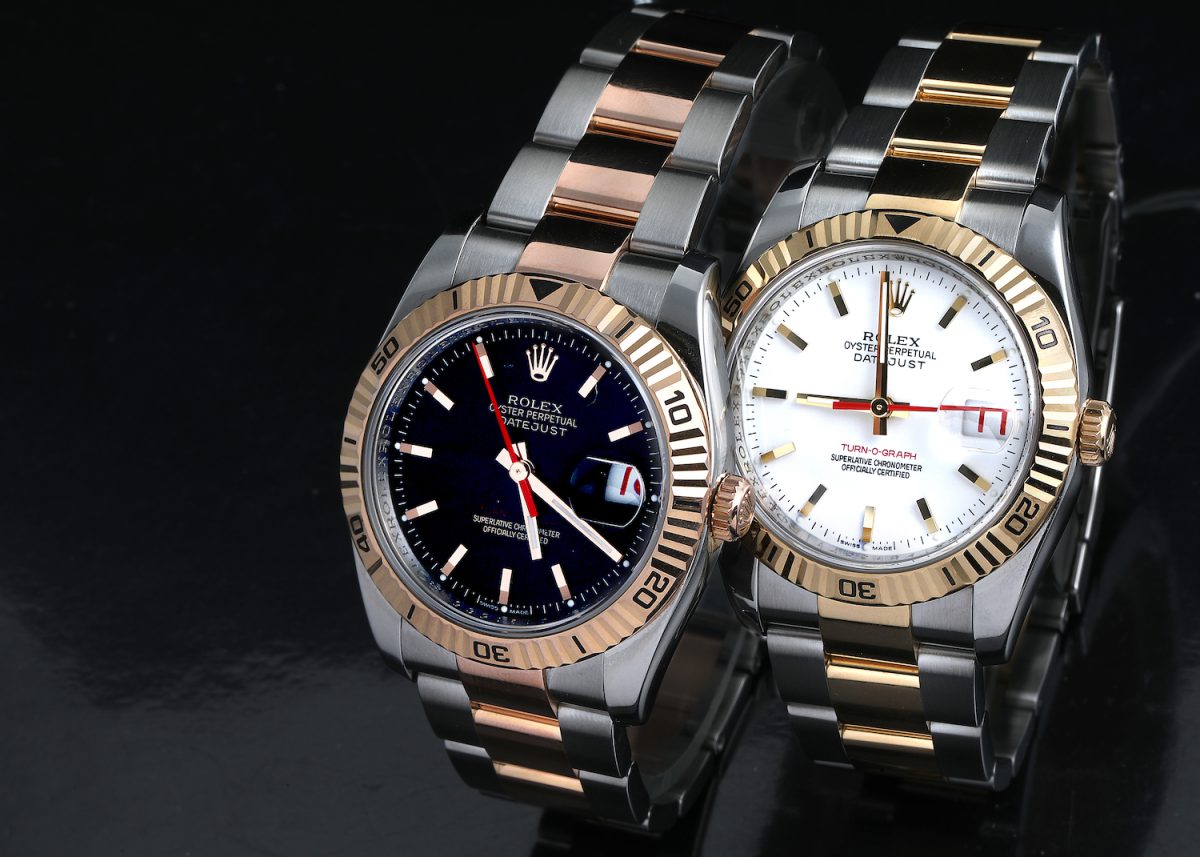
Rolex Turnograph Datejust Steel 18K Rose Gold Mens Watch 116261
This model is part of the six-digit references Rolex introduced in 2004, as a celebration of the 50th year of the Turn-o-Graph. It achieves a contemporary look with a new style case, more tapered lugs, and a fluted bezel in place of the engine turned bezel. Modern upgrades also include a double-sealed Twinlock screw down crown and a more solid five-piece Jubilee bracelet paired with a concealed Crownclasp.
What’s more, this edition introduced the rose gold metal to the collection. Previously, only yellow gold and white gold were paired with the stainless steel construction. Models produced after 2005 make use of Rolex’s patented rose gold alloy, Everose.
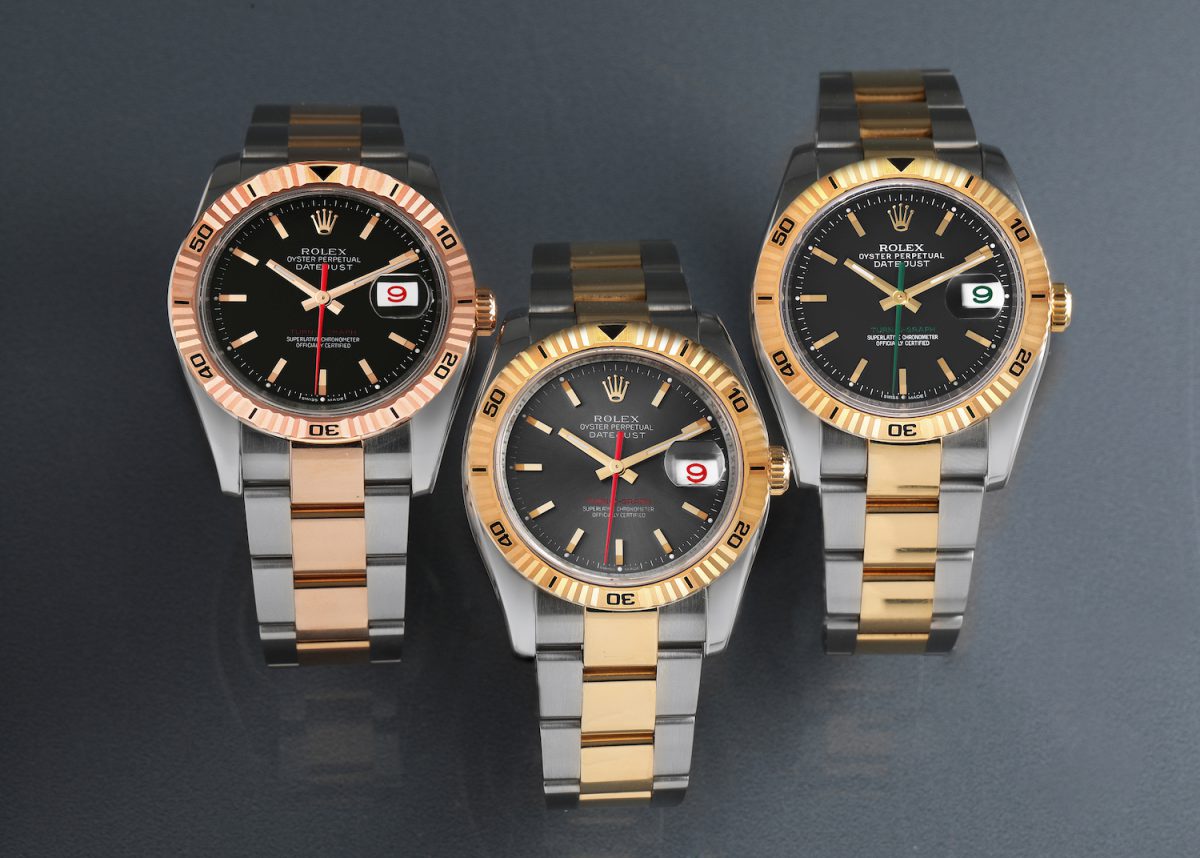
Rolex Turnograph Datejust Steel Yellow Gold Green Hand LE Watch 116263
In 2012, Rolex discontinued the Turn-o-Graph for good, but not before releasing a limited production exclusively for the Japanese market. The ref 116263 comes with a yellow gold and stainless steel finish, and the addition of green features (to replace the red details seen on the standard production models). The word Turn-o-Graph is written in Rolex green on the dial, and it also features a green seconds hand and green date wheel. Production for this watch was limited to 600 pieces – 300 for the white dial, and another 300 for the black dial version.
Common Questions about the Rolex Datejust Turn-o-Graph
Part tool watch, part dress watch, the Rolex Turn-O-Graph paved the way for many iconic Rolex watches of today. We answer the most frequently asked questions about the Rolex Datejust Turn-O-Graph.
What is a Rolex Turn-O-Graph watch?
The Turn-o-Graph is Rolex’s earliest tool watch, one that introduced the rotating timing bezel in 1953. Back then, this extra rim was an innovation – a new and simpler way of measuring elapsed time.
This feature would eventually be adopted by Rolex’s most beloved models such as the Submariner and GMT-Master.
The Turn-o-Graph was also the first Rolex sports watch to be produced in two-tone steel and gold.
 Modern Rolex Datejust Turn-o-Graph reference 116261 and 116263
Modern Rolex Datejust Turn-o-Graph reference 116261 and 116263
Is the Rolex Turn-O-Graph waterproof?
Rolex Turn-o-graph watches – from the original Turn-o-Graph to the Datejust Turn-o-Graph editions – are water resistant to 100 meters (330 feet), thanks to their Oyster case, screw down case back, and Oyster crown that secures them together.
With this level of water resistance and considering the vintage nature of the Turn-o-Graph, the wearer can use it for light water exposure, such as handwashing.
Is the Rolex Turn-o-Graph discontinued?
The Rolex Turn-o-Graph was produced from 1953 until 2011. Rolex has since stopped producing the Turn-o-Graph, but its models remain available in the secondary market.
—
With its place in the history of Rolex, the Turn-o-Graph is a model worth knowing and having. Explore our collection of Rolex Turn-o-Graph watches at SwissWatchExpo.com.


